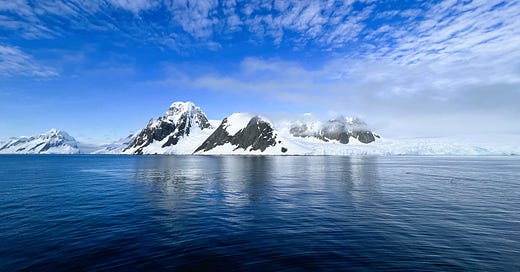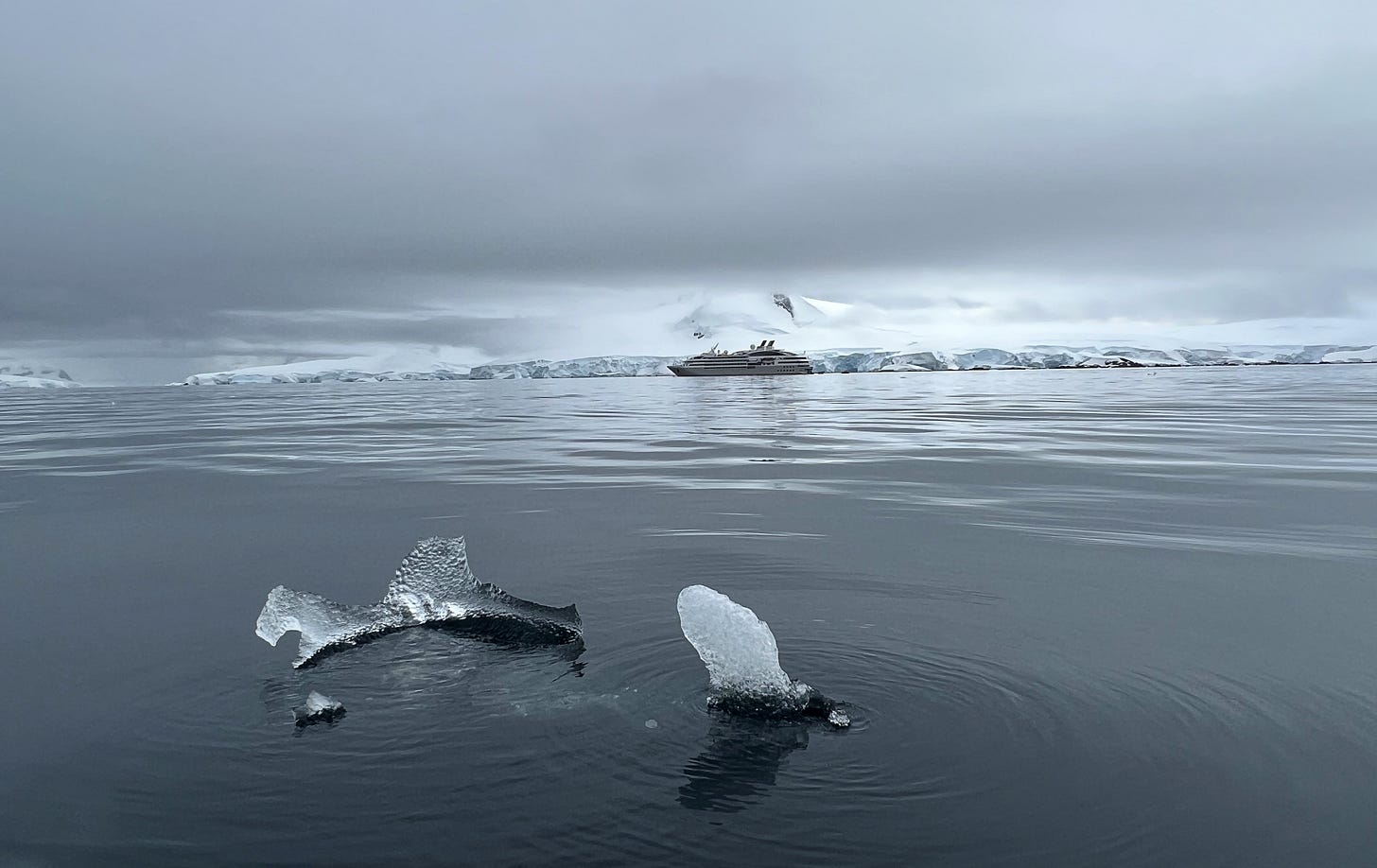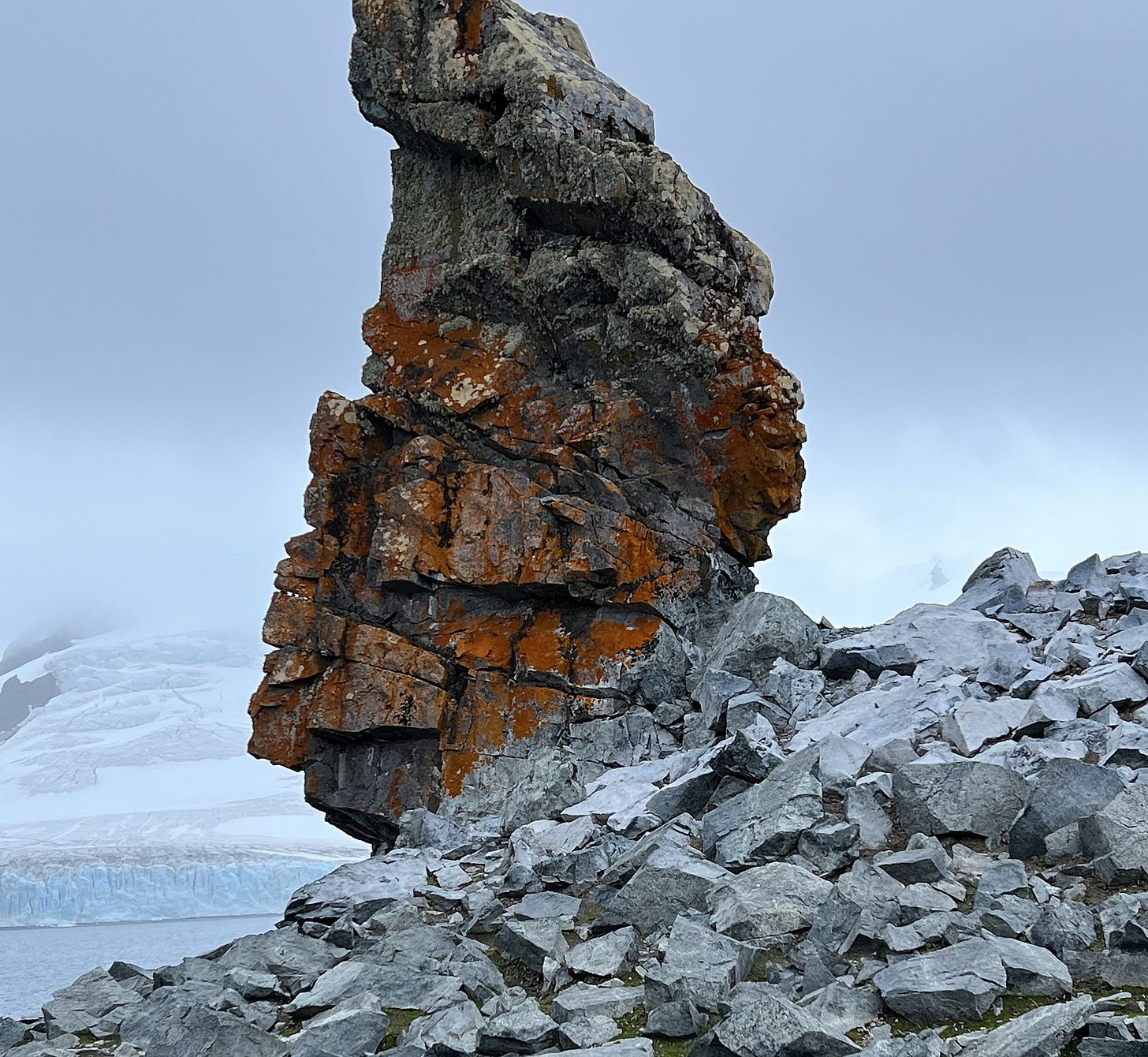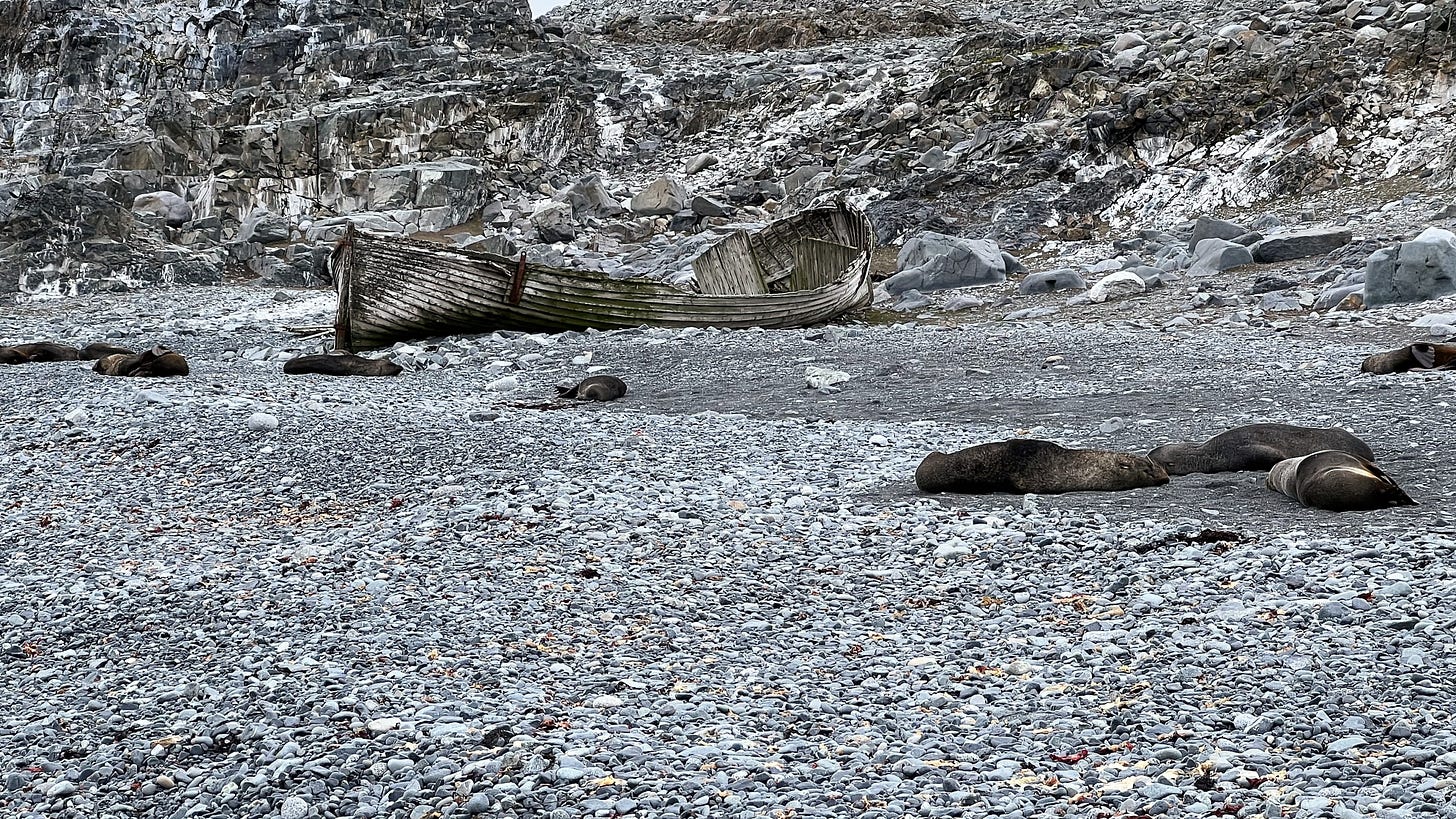I step onto my balcony and look out the shapes and colors in front of me — is this a lucid dream? Have I really made this trip? Is this really still Earth? A cold wind barrels through the protected inlet, ripping across the boat, biting my nose, shuddering the deck furniture. The Place is a glassy heaven one moment and a frigid snarl the next. Not a dream.
Veils of clouds come and go. The sky changes from rich azure to flat, dead gray on a minute-to-minute basis. When the clouds come in, the blues evaporate and are replaced, simply, with white. White foreground, white background. White ceiling, and a thick, matte, light-absorbing wall of water for a floor. I will have to write a separate story just on the waters here. I’ve never seen water look so clear and depthless.
The clouds roll on. Distance is a difficult thing to gauge. Look at the horizon: what horizon? What towers. And what lays beyond the white towers? More of them. More of them. Ice plains, and mountains, over and over and over. This peninsula is an extension of the Andes range; there are multiple peaks here at 8,000 feet or taller. When the clouds part: imagine a small window opening, and in this window, I can see another half-dozen ice colossuses that simply had not been there a few minutes prior.
Is this real? Am I really here?
The weather dictates everything here. We got lucky: our Drake crossing was easy and we arrived in peninsular waters early.
It is time to start exploring.
I don’t really know what our Expedition Leader means when he says “explore.” I do not personally consider myself an explorer. I am not fearful, but I do not envision myself as a lone man in the wilderness thinking, “this is where I am meant to be.” I would never bill myself as an outdoorsman. And yet when our leader says, “explore,” I can’t help but think of myself in new ways. I travel plenty. I eat just about anything. Are those not exploratory?
In the Antarctic context, I don’t know what “explore” means. I know we have a daily agenda. But I have no clue what to expect from it.
First, I have to dress properly.
A layer of Uniqlo thermals. Two layers of smart-wool socks. A polar fleece. Ski pants. A brilliant red heavy coat, courtesy of the tour. Life jacket — always — worn over the coat, like a vest. And heavy grey rubber boots. We’ll be stepping through plenty of penguin guano…
Second, I have to follow some unique cleanliness protocols.
Antarctica is a giant wildlife refuge. By treaty, it belongs to nobody. Countries have territorial claims — some of those claims even overlap — but Antarctica has been set aside. And this is part of our mandate as expeditioners: we must leave the place untouched.
We vacuum our jackets and pants and any garment with Velcro gets special attention. Why? Velcro is a debris trap, and we want to be debris-free. We don’t want to come to this sacred thing and defile it by accidentally leaving weeds behind. In our boots, we wade through antiviral-antimicrobial washes before and after each excursion.
Third —
The fun part.
The Boat is equipped with ten reinforced-rubber landing crafts called Zodiacs. This is the type of craft you’d envision Navy SEALs using to slip onto beaches at night. On the very top of The Boat, there’s a crane. Each Zodiac is winched down over the side of the boat and set gently into the water below.
At the stern (the rear of the boat), there is what we call a “marina.” The Zodiacs motor around and wait for us at a small dock-like structure. We newly minted explorers queue up above the marina, go down a small staircase and two sailors help us in to the idling smaller craft.
The Zodiac shoots away —
and suddenly I am face to face with sea ice.
It is all-but at my eye-level.
Thousand-year old ice, floating in a million-year-old bay… and me, and it, and the low hum of a rubber craft, pushing me toward a rocky beach.
Looking back, over my shoulder, I can see The Boat, grey, under a heavy ceiling of dead-flat grey clouds, with grey ice-plains looming —
Zodiac slows —
I look forward.
Land.
Two sailors are there, helping us onto the beach. One leg at a time, I swing myself out of the craft. The guides have been here already; sets of red flags mark off where we are and are not permitted to go. This is for our benefit, for the wildlife’s benefit, and to keep us out of active research areas.
What is there to do? Explore? But what is exploration? This is it. Look. See. Document. Feel.
Study the rock formations. Observe as firey hues of red and orange and rich browns and even greens emerge from a world that seems to be, mostly, cold slate.
Study bird behavior. Count their colonies. Watch them guard their nests and trek down to the water; watch them watch the waters before deciding it’s safe to swim.
You may even find signs of a human footprint. Europeans found Antarctica in the 1820s. The Maori may have sailed to The Place long before . In any event, human missions have left evidence behind. What is still here — old boats, old whaling station infrastructure — these are part of the record here, and they are to be as undisturbed as the wildlife.
(An amusing game: which are boulders, and which are fur seals? Fur seals have external ears and can walk on all four flippers. This actually makes them much closer to a sea lion than any of the other seals we saw. Leopard seals, crabeater seals and Weddell seals are all are considered “true seals” because they do not have external ears, nor do they walk like fur seals can.)
What does it mean to “explore?”
I would say it means to push into places you’d never been. To respect what you find and the conditions you found it in. It means to approach a new place with humility. It means to document. It means to wonder. Often enough, it means just be there and smell it, hear it, see it, and come back the next day, to keep pushing…










I'm on the edge of my seat! Really enjoying your account of this once in a lifetime adventure...
I am left breathless once again. It's one thing to DESCRIBE - it's quite another to CAPTURE. The selection of photographs is perfect - just so well matched to your narrative. I love traveling with you on this adventure and that's what you have made it feel like. Please, keep these essays coming!!